Achieving a Trade-Off Construction Solution Using BIM, an Optimization Algorithm, and a Multi-Criteria Decision-Making Method
Abstract
:1. Introduction
2. Methodology
2.1. Step 1
2.2. Step 2
2.3. Step 3
- HDGI>22 is the number of hours when the daylight glare index at the reference points exceeded;
- Hillu>500 is the number of hours when daylight illuminance at the reference points exceeded 500 lx;
- Et is the total energy needed for space heating and electricity for lighting and artificial ventilation;
- Kn is the present value of different construction solutions;
- PPD < 10 is the predicted percentage of dissatisfied smaller than 10, which was considered as an optimization constraint.
- Step one: The comparison matrix was normalized by dividing each value in the matrix by the sum of its respective column.
- Step two: The average of each row in the normalized matrix was quantified, which represented the weight of the objectives.
| A = | Visual comfort | Thermal comfort | Energy consumption | Life cycle cost | |
| Visual comfort Thermal comfort Energy consumption Life cycle cost | |||||
- λmax is the maximum eigenvalue of a comparison matrix;
- n is the number of values in the developed matrices;
- RI is the random consistency index.
2.3.1. First Scenario
| B = | Visual comfort | Thermal comfort | Energy consumption | Life cycle cost | Weight | |
| Visual comfort Thermal comfort Energy consumption Life cycle cost | 0.52 0.36 0.36 0.06 | |||||
| Weight | ||||
| C = | 0.667 0.333 | |||
2.3.2. Second Scenario
| D = | Visual comfort | Thermal comfort | Energy consumption | Life cycle cost | Weight | |
| Visual comfort Thermal comfort Energy consumption Life cycle cost | 0.167 0.167 0.167 0.499 | |||||
3. Results
3.1. Variation of the Criteria
3.2. Trade-Off Design Alternatives
4. Discussion
5. Conclusions
Author Contributions
Funding
Acknowledgments
Conflicts of Interest
Appendix A
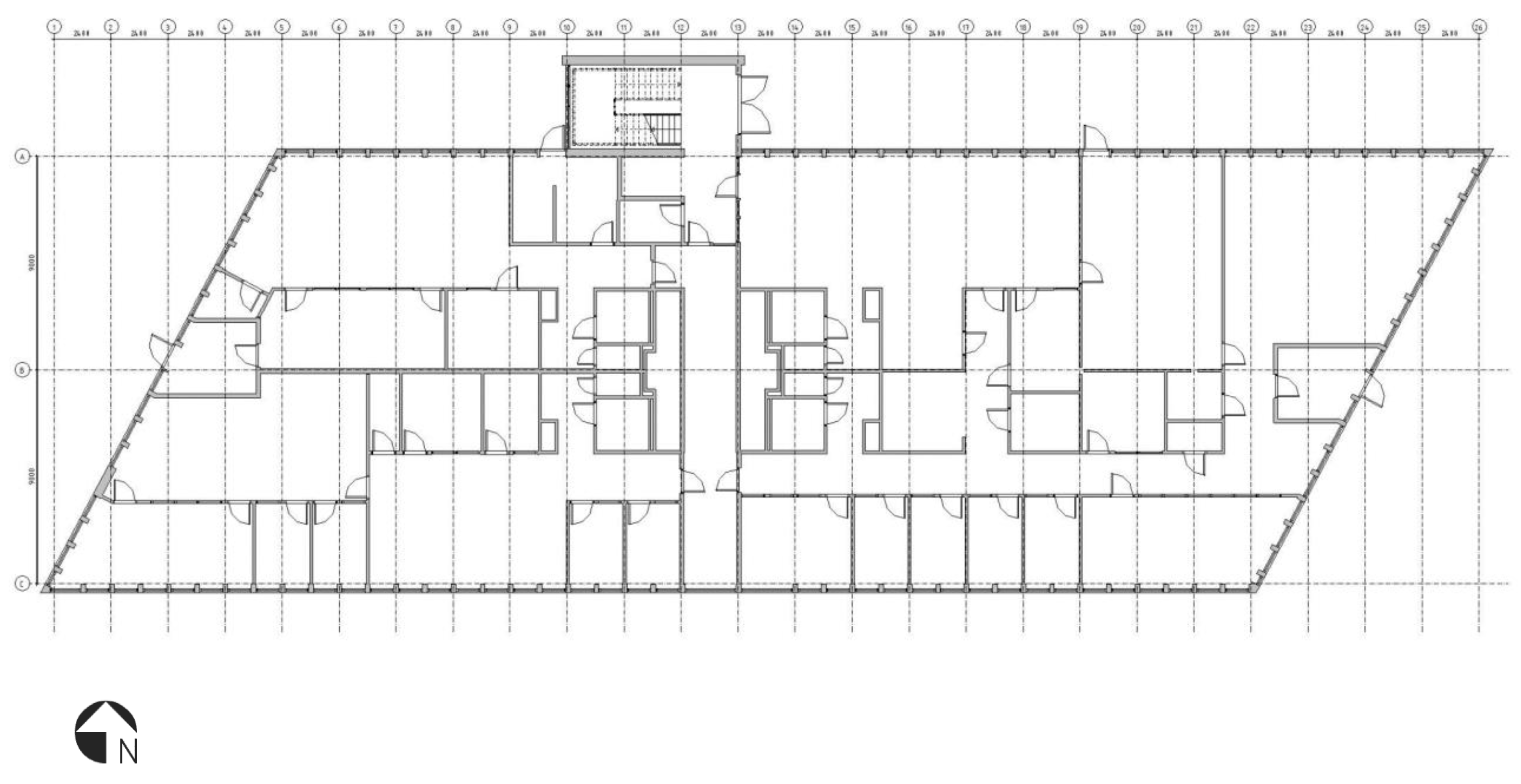
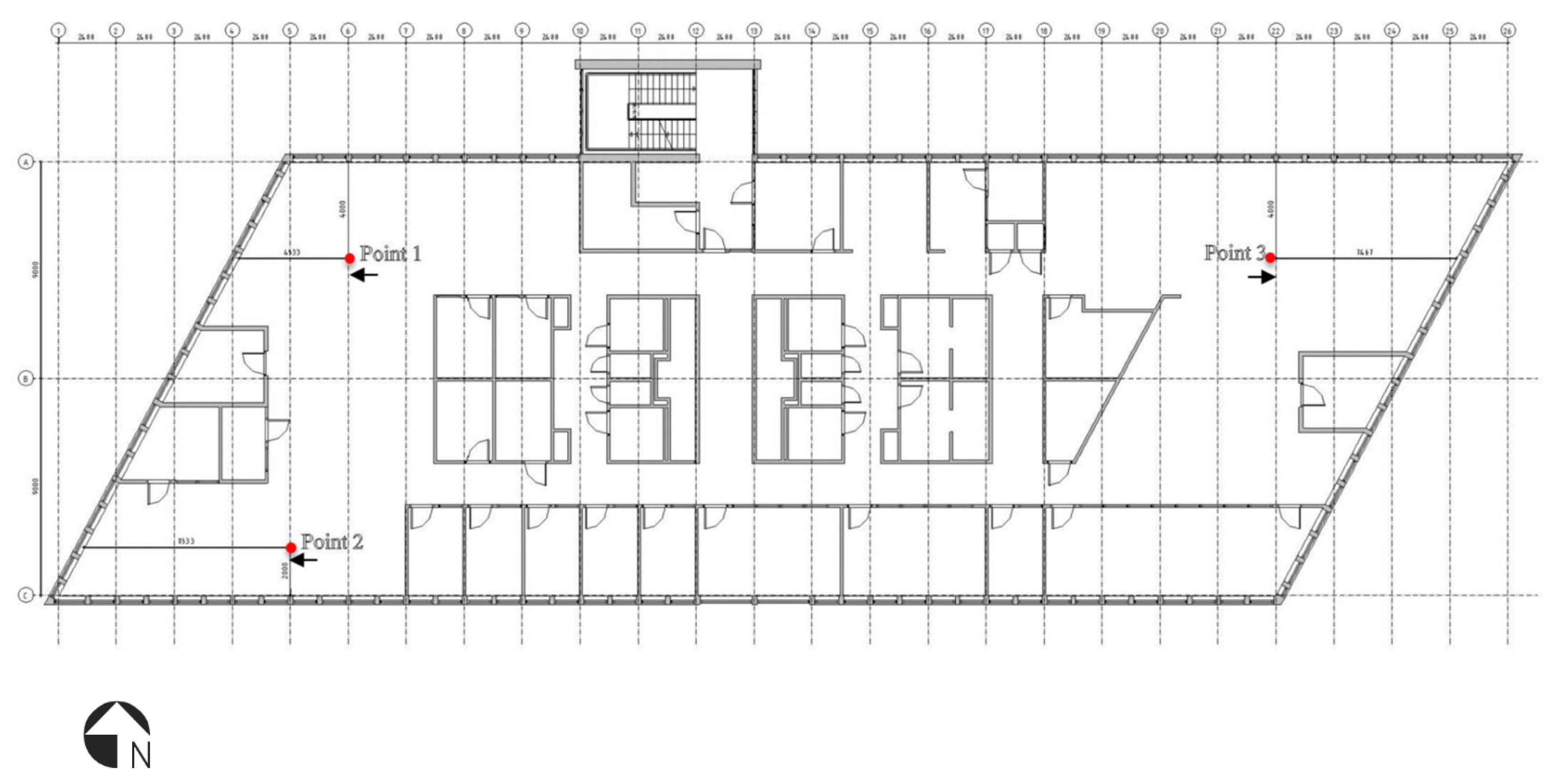
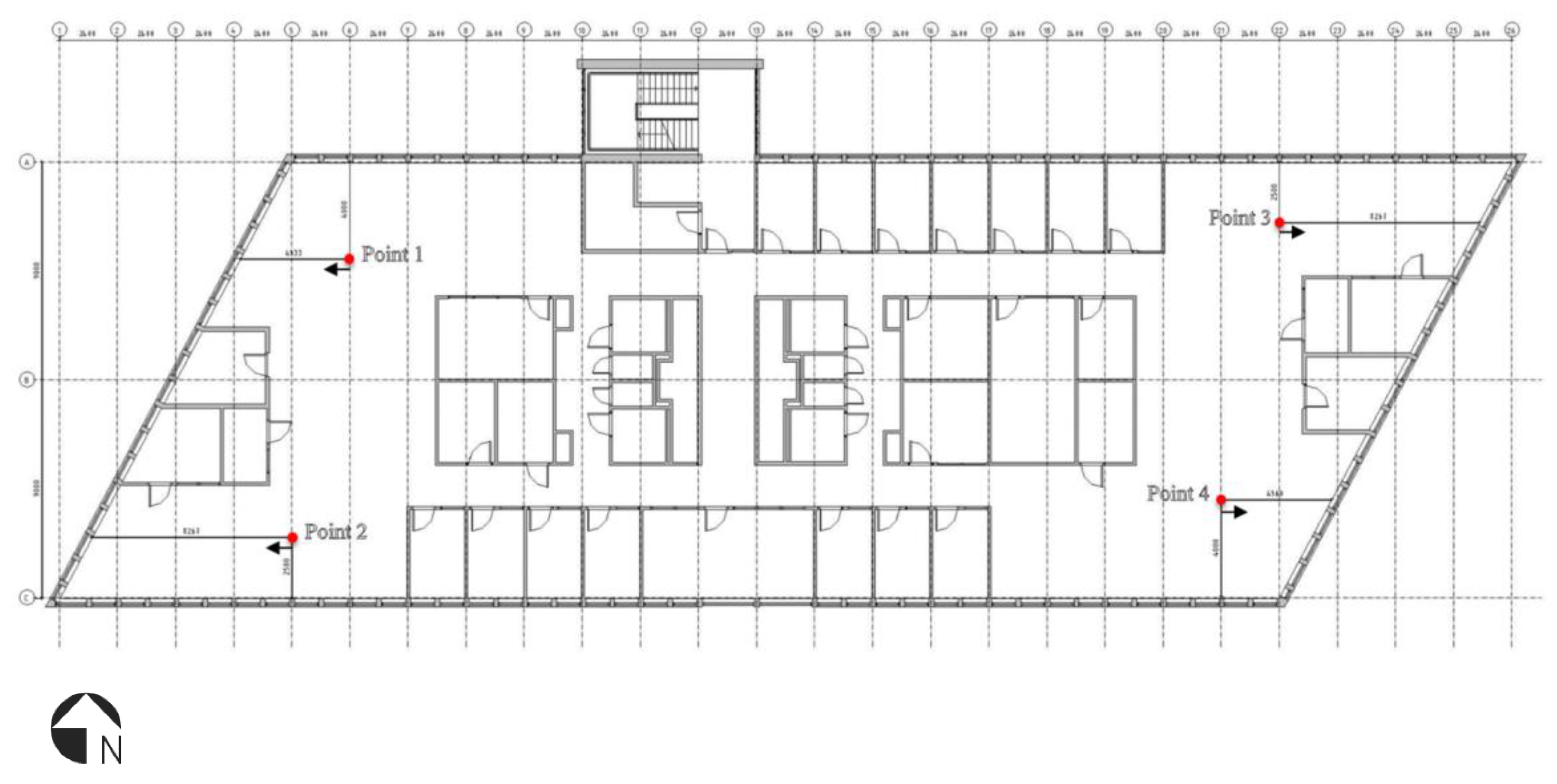
References
- Energy Performance of Building Directive (EPBD), ANNEX to the Proposal for a Directive of The European Parliament and of The Council. Amending Directive 2010/31/EU on the energy performance of buildings. Annex I, point 2. Off. J. Eur. Union 2016, 13–35. [Google Scholar]
- Swedish Energy Agency. Energy Statistics for Non-Residential Building 2016 [Energistatistik i lokaler 2016]; Swedish Energy Agency: Bromma, Sweden, 2017; p. 56. (In Swedish) [Google Scholar]
- Swedish Energy Agency. Energy Situation [Energiläget]; Swedish Energy Agency: Bromma, Sweden, 2017; pp. 1–86. (In Swedish) [Google Scholar]
- International Energy Agency. Energy Policies of IEA Countries, Sweden; International Energy Agency: Paris, France, 2013; pp. 1–182. [Google Scholar]
- Aries, M.; Aarts, M.; van Hoof, J. Daylight and health: A review of the evidence and consequences for the built environment. Lighting Res. Technol. 2015, 47, 6–27. [Google Scholar] [CrossRef]
- Heerwagen, J. Green buildings, organizational success and occupant productivity. Build. Res. Inf. 2000, 28, 353–367. [Google Scholar] [CrossRef]
- al Horr, Y.; Arif, M.; Kaushik, A.; Mazroei, A.; Katafygiotou, M.; Elsarrag, E. Occupant productivity and office indoor environment quality: A review of the literature. Build. Environ. 2016, 105, 369–389. [Google Scholar] [CrossRef]
- Kats, G.; Alevantis, L.; Mills, E.; Perlman, J. The Costs and Financial Benefits of Green Buildings: A Report to California’s Sustainable Building Task Force; California Department of Resources Recycling and Recovery: Sacramento, CA, USA, 2003. [Google Scholar]
- Muller, M.F.; Loures, E.R.; Canciglieri, O. Interoperability Assessment for Building Information Modelling. In Proceedings of the 5th International Conference on Structures and Building Materials (ICSBM 2015), Shenzhen, China, 28–29 March 2015. [Google Scholar]
- Asl, M.R.; Stoupine, A.; Zarrinmehr, S.; Yan, W. Optimo: A BIM-based Multi-Objective Optimization Tool Utilizing Visual Programming for High Performance Building Design. In Proceedings of the 33rd eCAADe Conference, Vienna University of Technology, Vienna, Austria, 16–18 September 2015; Martens, B., Wurzer, G., Grasl, T., Lorenz, W.E., Schaffranek, R., Eds.; pp. 673–682. [Google Scholar]
- Sakikhales, M.; Stravoravdis, S. Using BIM to facilitate iterative design, Building Information Modelling (BIM) in Design. Constr. Oper. 2015, 149, 9–19. [Google Scholar]
- Chand, S.; Wagner, M. Evolutionary many-objective optimization: A quick-start guide. Surv. Oper. Res. Manag. Sci. 2015, 20, 35–42. [Google Scholar] [CrossRef]
- Shadram, F.; Mukkavaara, J. An integrated BIM-based framework for the optimization of the trade-off between embodied and operational energy. Energy Build. 2018, 158, 1189–1205. [Google Scholar] [CrossRef]
- Sandberg, M.; Mukkavaara, J.; Shadram, F.; Olofsson, T. Multidisciplinary Optimization of Life-Cycle Energy and Cost Using a BIM-Based Master Model. Sustainability 2019, 11, 286. [Google Scholar] [CrossRef]
- Sanchez, A.X.; Hampson, K.D.; Vaux, S. Delivering Value with BIM: A Whole-of-Life Approach; Routledge: Abingdon, UK, 2016. [Google Scholar]
- Gustavsson, T.K.; Samuelson, O.; Wikforss, Ö. Organizing it in construction: Present state and future challenges in Sweden. J. Inf. Technol. Constr. 2012, 17, 520–534. [Google Scholar]
- Davies, R.; Crespin-Mazet, F.; Linné, Å.; Pardo, C.; Havenvid, M.I.; Harty, C.; Ivory, C.; Salle, R. BIM in Europe: Innovation networks in the construction sectors of Sweden, France and the UK. In Proceedings of the 31st Annual ARCOM Conference, Lincoln, UK, 7–9 September 2015; Raidén, A.B., Aboagye-Nimo, E., Eds.; Association of Researchers in Construction Management; pp. 1135–1144. [Google Scholar]
- Bosch-Sijtsema, P.; Isaksson, A.; Lennartsson, M.; Linderoth, H.C. Barriers and facilitators for BIM use among Swedish medium-sized contractors—“We wait until someone tells us to use it”. Vis. Eng. 2017, 5, 3. [Google Scholar] [CrossRef]
- Jalilzadehazhari, E.; Johansson, P.; Johansson, J.; Mahapatra, K. Developing a decision-making framework for resolving conflicts when selecting windows and blinds. Archit. Eng. Des. Manag. 2018. [Google Scholar] [CrossRef]
- Mosavi, A. Multiple criteria decision-making preprocessing using data mining tools. arXiv 2010, arXiv:1004.3258. [Google Scholar]
- Revit. 2017. Available online: https://www.autodesk.com/products/revit-family/overview (accessed on 3 December 2017).
- Design Builder. 2017. Available online: www.designbuilder.co.uk (accessed on 12 December 2018).
- Jalilzadehazhari, E.; Johansson, P.; Johansson, J.; Mahapatra, K. Application of analytical hierarchy process for selecting an interior window blind. Archit. Eng. Des. Manag. 2017, 13, 308–324. [Google Scholar] [CrossRef]
- National Board of Housing Building and Planning. Building Regulation [Boverkets Byggregler, BFS 2011: 6 med ändringar till och med 2015: 3]; National Board of Housing, Building and Planning [Boverket]: Karlskrona, Sweden, 2015. (In Swedish) [Google Scholar]
- Gustafsson, M.; Gustafsson, M.S.; Myhren, J.A.; Bales, C.; Holmberg, S. Techno-economic analysis of energy renovation measures for a district heated multi-family house. Appl. Energy 2016, 177, 108–116. [Google Scholar] [CrossRef]
- Flodberg, K. Very Low Energy Office Buildings in Sweden; Lund University: Lund, Sweden, 2012. [Google Scholar]
- Månsson, L. Light & Room, Guide for Planning of Indoor Lighting [Ljus & Rum: Planeringsguide för Belysning Inomhus]; Ljuskultur: Stockholm, Sweden, 2003. (In Swedish) [Google Scholar]
- Al-Sallal, K. Low Energy Low Carbon Architecture: Recent Advances & Future Directions; CRC Press: Boca Raton, FL, USA, 2016. [Google Scholar]
- Bülow-Hübe, H. Solar Shading and Daylight Redirection, Architecture and Built Environment. Ph.D. Thesis, Lund University, Lund, Sweden, 2007. [Google Scholar]
- Elitfonster. 2016. Available online: www.elitfonster.se (accessed on 24 January 2018).
- I.S.W.B. Wikells construction calculations, AB]. Sectional Facts—NYB 12/13: Technical-Economic Compilation of Buildings [Sektionsfakta—NYB 12/13: Teknisk-ekonomisk sammanställning av byggdelar], 22nd ed.; Wikells Byggberäkningar: Växjö, Sweden, 2012. (In Swedish)
- Koziel, S.; Yang, X.S. Computational Optimization, Methods and Algorithms; Springer: Berlin/Heidelberg, Germany, 2011. [Google Scholar]
- Pourshaghaghy, A.; Omidvari, M. Examination of thermal comfort in a hospital using PMV–PPD model. Appl. Ergon. 2012, 43, 1089–1095. [Google Scholar] [CrossRef] [PubMed]
- Saaty, T.L. How to make a decision: The analytic hierarchy process. Eur. J. Oper. Res. 1990, 48, 9–26. [Google Scholar] [CrossRef]
- Saaty, T.L. Decision making with the analytic hierarchy process. Int. J. Serv. Sci. 2008, 1, 83–98. [Google Scholar] [CrossRef]
- Ordouei, M.H.; Elkamel, A.; Dusseault, M.B.; Alhajri, I. New sustainability indices for product design employing environmental impact and risk reduction: Case study on gasoline blends. J. Clean. Prod. 2015, 108, 312–320. [Google Scholar] [CrossRef]
- Hotman, E. Base reference analytical hierarchy process for engineering process selection. In Proceedings of the International Conference on Knowledge-Based and Intelligent Information and Engineering Systems, Melbourne, Australia, 14–16 September 2005; Springer: Berlin/Heidelberg, Germany, 2005; pp. 184–190. [Google Scholar]
- Frontczak, M.; Andersen, R.V.; Wargocki, P. Questionnaire survey on factors influencing comfort with indoor environmental quality in Danish housing. Build. Environ. 2012, 50, 56–64. [Google Scholar] [CrossRef]
- Chung, T.; Ng, R. The application of analytic hierarchy process in daylighting performance assessment. Indoor Built Environ. 2016, 25, 50–68. [Google Scholar] [CrossRef]
- EPBD, Directive 2010/31/EU of the European Parliament and of the Council of 19 May 2010 on the energy performance of buildings (recast). Off. J. Eur. Union 2010, 18, 2010.
- Emanuelsson, R. Supply of housing in Sweden. Sver. Riksbank Econ. Rev. 2015, 2, 47–75. [Google Scholar]
- Carlucci, S.; Cattarin, G.; Causone, F.; Pagliano, L. Multi-objective optimization of a nearly zero-energy building based on thermal and visual discomfort minimization using a non-dominated sorting genetic algorithm (NSGA-II). Energy Build. 2015, 104, 378–394. [Google Scholar] [CrossRef]
- Hamdy, M.; Hasan, A.; Siren, K. Applying a multi-objective optimization approach for Design of low-emission cost-effective dwellings. Build. Environ. 2011, 46, 109–123. [Google Scholar] [CrossRef]
- Niemelä, T.; Kosonen, R.; Jokisalo, J. Cost-optimal energy performance renovation measures of educational buildings in cold climate. Appl. Energy 2016, 183, 1005–1020. [Google Scholar] [CrossRef]
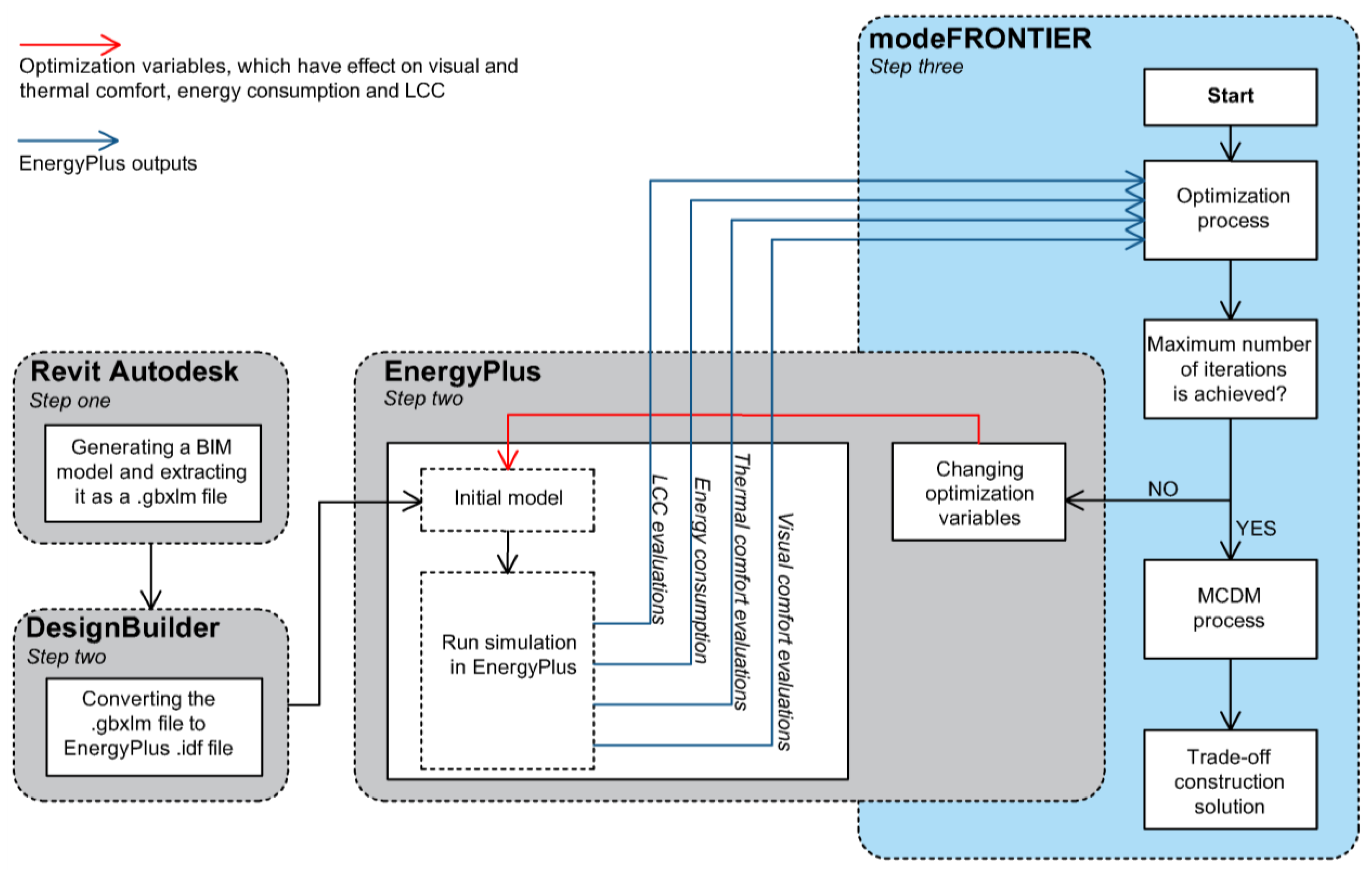
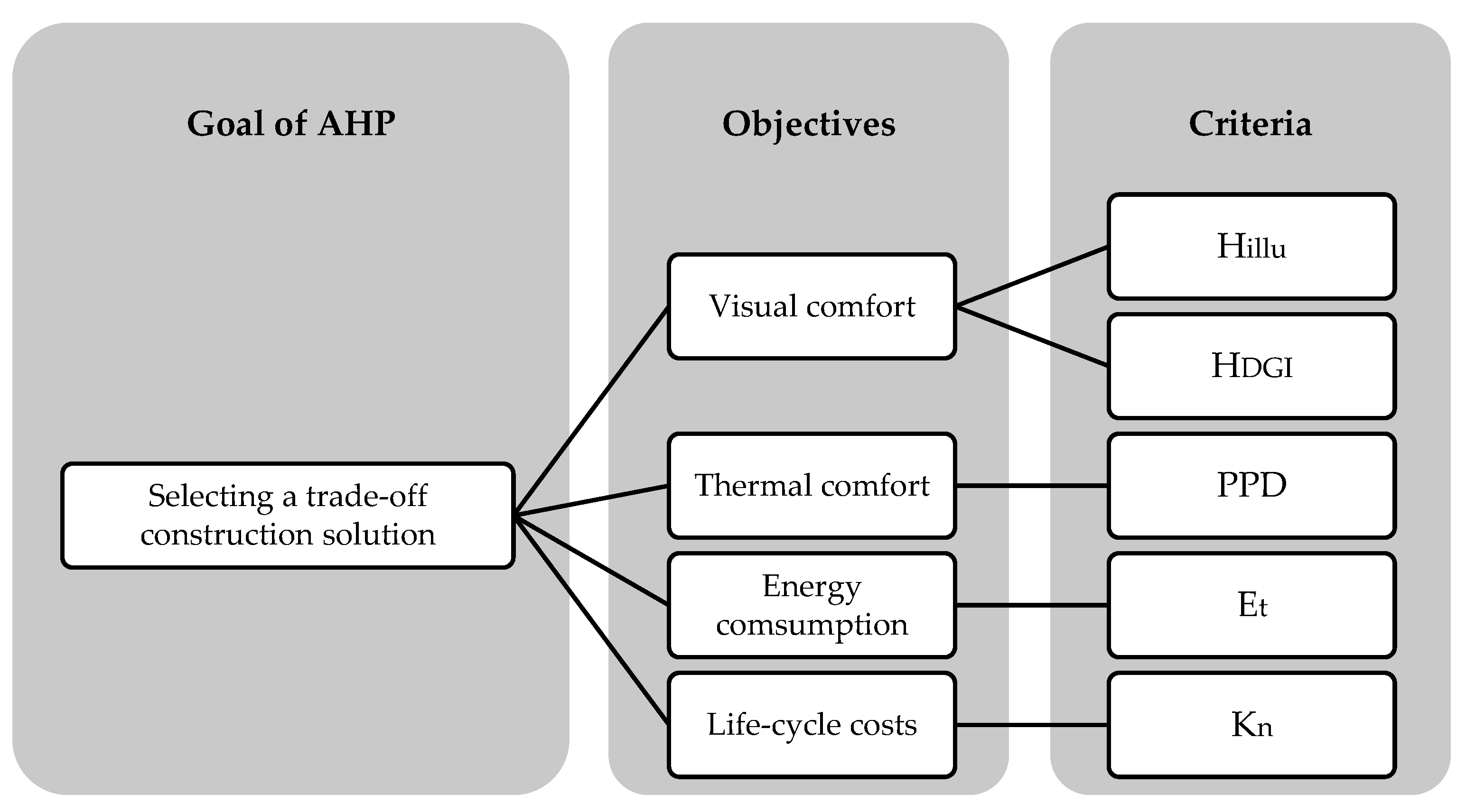
| The efficiency of the ventilation fan | 60% |
| The efficiency of the heat recovery system | 76% |
| Indoor temperature | 18 °C to 22 °C |
| Air tightness [26] Occupancy activity Clothing resistance Artificial lighting Occupancy schedule The reflectance of interior surfaces [27] | 0.1 (ach) at a differential pressure of ± 50 (Pa) 1.2 (met) 0.5 (clo) in summer and 1 (clo) in winter Fluorescent electrical lighting with 9.9 (W/m²) power 07:00 to 18:00 on working days only Walls 60% Ceiling 80% Floor 20% |
| Building Envelopes | U-Value (W/K·m²) | Investment Costs (SEK ¹/m²) | Lifespan | Description |
|---|---|---|---|---|
| Windows [30] | ||||
| Type 1 | 0.9 | 4665 | 30 | VT ² = 65%, SHGC³ = 45% |
| Type 2 | 0.8 | 5830 | 30 | VT ² = 63%, SHGC³ = 43% |
| Type 3 | 0.7 | 6020 | 30 | VT ² = 60%, SHGC³ = 41% |
| External walls [31] | ||||
| Type 1 | 0.18 | 1403.6 | 30 | |
| Type 2 | 0.14 | 1433 | 30 | |
| Type 3 | 0.12 | 1505.7 | 30 | |
| Type 4 | 0.1 | 1530 | 30 | |
| Type 5 | 0.09 | 1599 | 30 | |
| Ground floor [31] | ||||
| Type 1 | 0.15 | 589.5 | 30 | |
| Type 2 | 0.12 | 711.4 | 30 | |
| Type 3 | 0.1 | 758 | 30 | |
| Type 4 | 0.09 | 880 | 30 | |
| Type 5 | 0.08 | 956 | 30 | |
| External roof [31] | ||||
| Type 1 | 0.13 | 389 | 30 | |
| Type 2 | 0.12 | 411 | 30 | |
| Type 3 | 0.1 | 426.2 | 30 | |
| Type 4 | 0.09 | 445.4 | 30 | |
| Type 5 | 0.08 | 463.4 | 30 |
| Scale | Description |
|---|---|
| 1 | jn is equally important to jm |
| 3 | jn is moderately more important than jm |
| 5 | jn is strongly more important than jm |
| 7 | jn is very strongly more importance than jm |
| 9 | jn is extremely more important than jm |
| n | 1 | 2 | 3 | 4 | 5 | 6 | 7 | 8 | 9 | 10 |
|---|---|---|---|---|---|---|---|---|---|---|
| RI | 0 | 0 | 0.58 | 0.9 | 1.12 | 1.24 | 1.32 | 1.41 | 1.45 | 1.49 |
| Reference Points | Window Type 1 (h) | Window Type 2 (h) | Window Type 3 (h) |
|---|---|---|---|
| Second Floor, point 1 | 258.5 | 159 | 74.5 |
| Second Floor, point 2 | 55.5 | 25.5 | 4 |
| Second Floor, point 3 | 2619 | 2520.5 | 2400 |
| Third Floor, point 1 | 324.5 | 215 | 129 |
| Third Floor, point 2 | 53.3 | 29.5 | 13.5 |
| Third Floor, point 3 | 171.5 | 125 | 86.5 |
| Third Floor, point 4 | 173.4 | 126 | 89 |
| Reference Points | Window Type 1 (h) | Window Type 2 (h) | Window Type 3 (h) |
|---|---|---|---|
| Second Floor, point 2 | 229.5 | 164 | 112 |
| Third Floor, point 2 | 235 | 176 | 119 |
| Scenarios | First Scenario Visual Comfort Is the Most Important Objective When Applying AHP | Second Scenario Life Cycle Cost Is the Most Important Objectives When Applying AHP |
|---|---|---|
| First trade-off design alternative | Second trade-off design alternative | |
| Window | 1 | 1 |
| Ground floor | 5 | 1 |
| Roof | 5 | 3 |
| External wall | 5 | 2 |
| PPD | 6.20% | 6.50% |
| Et | 62.5 kWh/m2 | 64.7 kWh/m2 |
| Kn | 8.5 MSEK | 8 MSEK |
| Total investment | 5.75 MSEK | 5.2 MSEK |
© 2019 by the authors. Licensee MDPI, Basel, Switzerland. This article is an open access article distributed under the terms and conditions of the Creative Commons Attribution (CC BY) license (http://creativecommons.org/licenses/by/4.0/).
Share and Cite
Jalilzadehazhari, E.; Vadiee, A.; Johansson, P. Achieving a Trade-Off Construction Solution Using BIM, an Optimization Algorithm, and a Multi-Criteria Decision-Making Method. Buildings 2019, 9, 81. https://doi.org/10.3390/buildings9040081
Jalilzadehazhari E, Vadiee A, Johansson P. Achieving a Trade-Off Construction Solution Using BIM, an Optimization Algorithm, and a Multi-Criteria Decision-Making Method. Buildings. 2019; 9(4):81. https://doi.org/10.3390/buildings9040081
Chicago/Turabian StyleJalilzadehazhari, Elaheh, Amir Vadiee, and Peter Johansson. 2019. "Achieving a Trade-Off Construction Solution Using BIM, an Optimization Algorithm, and a Multi-Criteria Decision-Making Method" Buildings 9, no. 4: 81. https://doi.org/10.3390/buildings9040081
APA StyleJalilzadehazhari, E., Vadiee, A., & Johansson, P. (2019). Achieving a Trade-Off Construction Solution Using BIM, an Optimization Algorithm, and a Multi-Criteria Decision-Making Method. Buildings, 9(4), 81. https://doi.org/10.3390/buildings9040081







